Features of planting a columnar apple tree
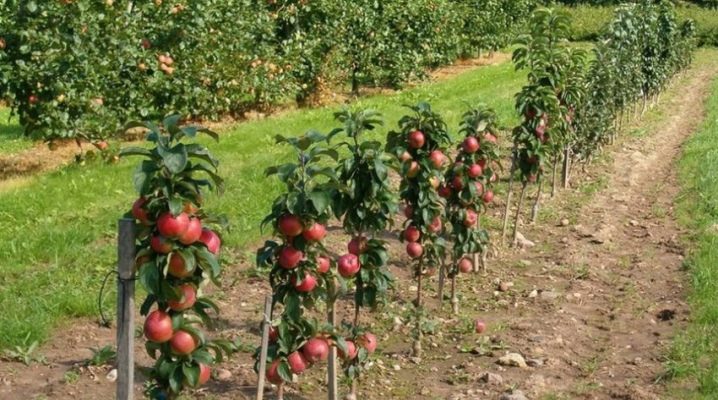
Columnar apple trees are becoming more popular every year; there are about a hundred varieties for growing in the garden. Many people strive to acquire such a variety at their summer cottage. How to prepare the soil and seedlings for planting, when it is better to do it, as well as other agrotechnical tricks are described in our material.
Timing
For successful survival in the open field, seedlings are recommended to be planted in spring or autumn. Be sure to choose days with favorable weather.
Do not land in strong winds, rain or heat. Ideally, if it is cloudy and warm, calm. In sunny weather, the procedure is postponed to the evening.

Spring planting
Most suitable for varieties with low frost resistance... This is the only favorable time for areas where winters are long and harsh. It is also recommended to plant in areas with clay soils in the spring.
The planting of a columnar apple tree must be completed before the buds begin to swell, but by these numbers the earth should already warm up to +10 degrees, the air - to a temperature of + 15 ° C. In different climatic conditions, the event is held at different times. It is important not to be late - if you plant a tree, when the buds begin to bloom on the branches, then it will not have time to take root and will not grow up this year.
In spring, annual seedlings take root better, their survival rate is much higher than that of two-year-olds.
In the Moscow region and the Leningrad region, they are planted in mid or late April, in the Urals and Siberia, such work is postponed until the second decade of May.
When choosing a variety for a garden, one must focus on the characteristics of the soil composition, climatic conditions, resistance to cold and disease, and only then on the taste and color of the fruit.
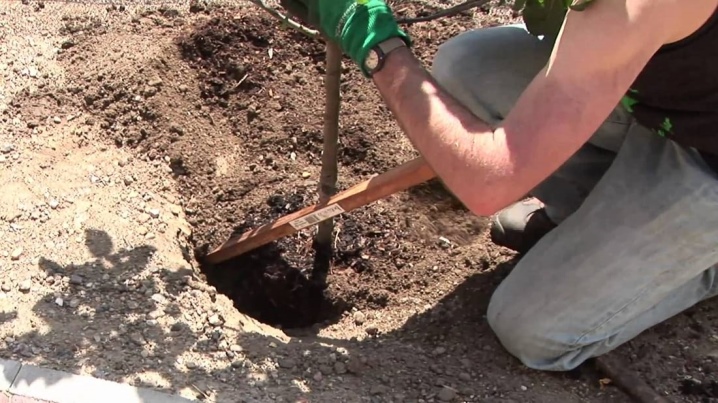
Autumn planting
Suitable for trees over two years old, as well as winter-hardy species. Usually carried out after the end of the leaf fall. Warm days from the beginning of September to the middle of the month are most favorable, but no later than 25-30 days before the onset of frost. At a temperature of +4 degrees, the development of the roots stops. When the temperature drops below 0 ° C, there is a risk of seedlings freezing. For the winter period, it is imperative to create an additional shelter.
The autumn planting time also directly depends on the climate of the region. In the Moscow region and the Leningrad region, planting operations are carried out in late September - early October. In Siberia and the Urals, this is done a month earlier. The tree must have time to root in the open field. A delay in planting will lead to a delay in the development of the seedling and even death.
If in the fall the summer resident does not have time with the landing, then it is better to postpone the event to the spring. The seedling can be stored in a cool place in a container or in a bag of soil.
With a closed root system, it should be watered every 3 days. The roots should never dry out. You can dig in on an area protected from the wind right in the container.
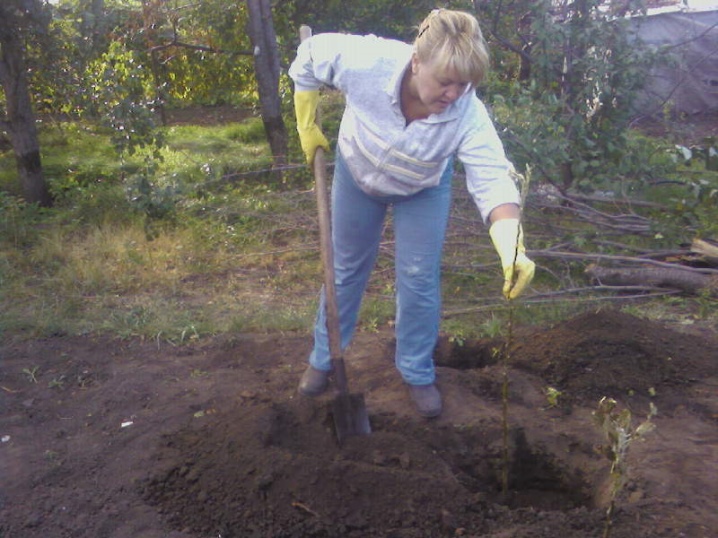
What varieties of columnar apple trees are suitable for different regions?
- Leningrad region. Suitable for weather changes, with a good level of winter hardiness: Arbat, Garland, Chervonets, Amber necklace.
- Northwestern part of Russia. In this climate, the life of a tree is 6-8 years. They choose varieties with a high level of frost resistance, which can be grown in gardens both in the Moscow region and in Arkhangelsk.These are Moscow necklace, Vasyugan, Ostankino, President, Medoc, Dialogue, Chervonets.
- Central Russia. In Moscow and in the regions located to the south, unpretentious, winter-hardy varieties with good yield indicators are also selected. These include: Arbat, Bolero, Yesenia, Renet Mazherova, Currency, Moscow necklace, Malyukha.
- Ural... In colder climates, many fruit crops become weaker. Disease-resistant and winter-hardy species are required: Arbat, Vasyugan, Currency, Gin (undersized - up to 1.5 meters), Medok, President, Ostankino, Barguzin.
- Siberia... They give preference to varieties that can withstand severe frosts: President, Vasyugan, Iksha, Barguzin. When grown in a polycarbonate greenhouse, columnar varieties begin to bloom in late April - early May, and bear fruit from the end of June.
- Belarus... For a climate with humid air and cold winters, winter-hardy apple trees are selected, undemanding to soils, resistant to fungal diseases and all kinds of rot. These are the varieties: Vasyugan, Malyukha, Jin, Triumph, Currency, Moscow necklace.
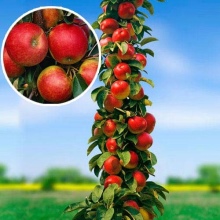
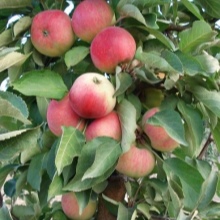
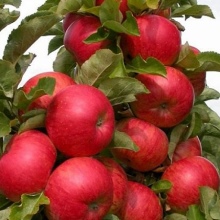
Site requirements
For young plants, you need to find a suitable place on the site.
- Fertile soil - sandy loam or loamy. If there is no fertile layer on the site, then it is poured.
- A sunny place without drafts, on the south or west side of the garden, sheltered from the wind. Usually near buildings or a fence, but so that the plant does not shade, they make an indent of about a meter.
- High humidity level. The location of groundwater is not higher than 2 meters from the surface of the earth. With a closer lying, it is required to create drainage.
- The variety is chosen taking into account the climatic conditions of a particular region. For the north, take species adapted to low temperatures.
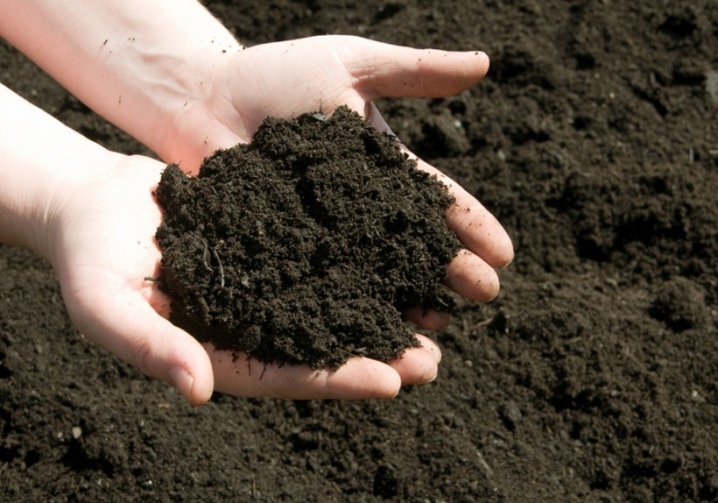
How to prepare a pit?
Trenches or planting holes are prepared for seedlings. A trench is a deep groove made for several plants at once. It is used when creating a garden. The width and depth of the trench is 50x50 cm.
Pits are used for planting separate or far apart apple trees. As a rule, the depth and width are 70-80 cm, depending on the variety on which the columnar apple tree is grafted. The deepening is made of such a size that the roots of a young tree can freely fit in it.
They dig and prepare planting holes in advance: for spring - in autumn, and for autumn - in spring or no later than 1.5 months before the event.
For a columnar apple tree, light sandy loam or loamy soil is suitable. The root system of the plant does not go deep into the soil, but is located on the surface. The variety is very demanding on moisture and fertile layer.
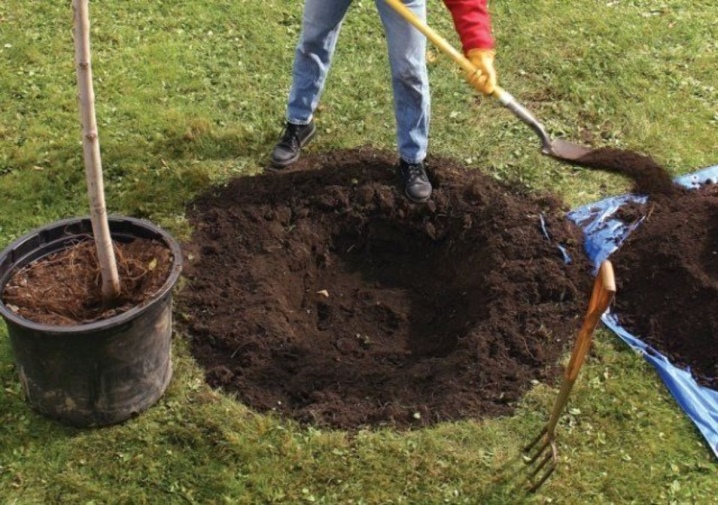
Be sure to add to the holes:
- organic fertilizers (humus, peat) - 5 kg;
- mineral (superphosphate - 100 g, potassium - 80 g);
- ash - 500 g;
- acidic soils are neutralized with dolomite flour.
Most of the pit is filled with fertile soil mixed with compost or humus and potassium-phosphorus additives. Complex mineral supplements are not recommended. All components are mixed and left for the winter for spring planting. If it is planned to plant in the fall, then mineral fertilizing is not applied, so as not to stimulate the seedlings to grow. In this case, fertilization begins only in the spring.
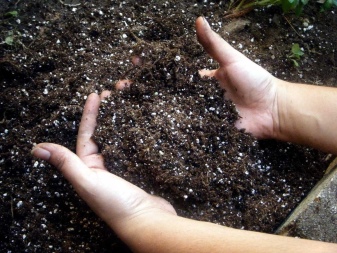

When preparing, take into account the characteristics of the land on the site.
- Clayey... Clay does not allow water to pass through well, and water will accumulate in a hole filled with a fertile composition. They dig deep recesses up to 1.5 meters, lay out a thick layer of drainage from sand, crushed stone or broken brick, you can use other materials. Sand and sawdust must be added to the composition of the earth.
- Sandy... Loose substrates almost do not retain moisture, so the root system will dry out quickly. The pit is made with a size of 80x80 cm. Drainage must be arranged. Dense compounds are added to the hole at the bottom to retain moisture - river silt, clay. Dolomitized lime is added to the soil to enrich it with magnesium.The side walls of the hole are reinforced with materials at hand.
- Peat... High acidity on peat soils. To neutralize it, add chalk, slaked lime, dolomite flour. For greater looseness and water permeability, sand is introduced.
- With a high level of groundwater. The depth of the location of the water should not exceed 2 m from the surface. If, nevertheless, the waters rise higher, gardeners make earthen embankments or high beds on which apple trees are planted. They also organize a drainage system using drainage pipes.
It is advised to choose varieties on a dwarf rootstock.

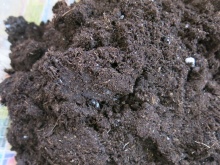
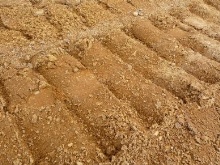
Schemes
Placing young trees on the site, be sure to take into account which varieties will be nearby. The peculiarities of the stock on which the columnar apple trees are grafted are also taken into account - they distribute the seedlings so that the taller trees do not shade the lower ones.
There are 3 groups:
- dwarf - up to 2 m;
- semi-dwarf - up to 3 m;
- tall - above 3 m.
The timing of ripening also affects how the apple trees are grouped with each other. There are summer, autumn and late groups. It is better to plant trees of the same fruiting period nearby, so it will be more convenient to look after them.
You also need to follow a certain order when seating. A distance of at least 40 cm is left between the trees. At least 1 meter between the rows, so as not to create additional shadow. It is not recommended to plant it alone, it can be combined with other types of fruit trees. Only the Moscow Necklace variety can be planted separately.
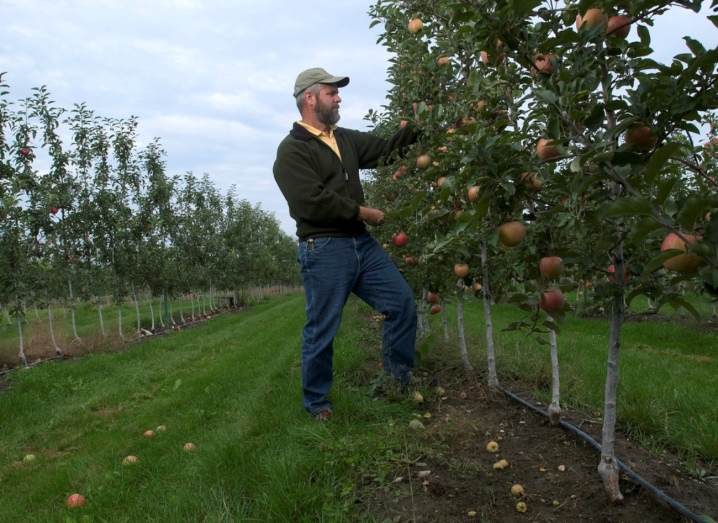
Single plantings will bear fruit if there are suitable pollinators nearby. There should be another apple tree nearby, blooming at the same time as the columnar one. This is necessary for successful cross-pollination and fruit setting.
Basic schemes for disembarkation.
- Tape... It is often used in the industrial cultivation of fruit trees. They are planted in rows with an interval of 50-80 cm, an interval of 80-150 cm is made between the rows. With this arrangement, the plants are optimally provided with light and nutrients. It is often used to create alleys of fruit trees or place a row along a fence. This scheme is indispensable for a small area.

- Chess... Suitable for planting varieties with different ripening periods. Seedlings are placed at a distance of 0.50 to 1.5 meters, often the spacing is made larger for seedlings on high rootstocks. Planting holes are dug at the tops of a square, the side of which is approximately 1 meter. 4 trees are planted in the corners, and the fifth in the center of the figure. This method is most suitable for the southern regions of the Russian Federation.

- Creeping... In areas with harsh winters, experienced gardeners grow a columnar apple tree in a creeping form. The peculiarities of this planting method are that young trees are planted in 2 rows according to the following scheme:
- the distance between them is 0.8-1 meter;
- between the rows - 1 meter.
Options for how to make a creeping variety:
- plant a tree at an angle of 30 °;
- the trunk is filed and bent to the ground at an angle of 90 °.
For the cultivation of creeping forms, the stock is suitable - M-9, P-9. The advantages of such forms are that they can be easily sheltered from frost for the winter.
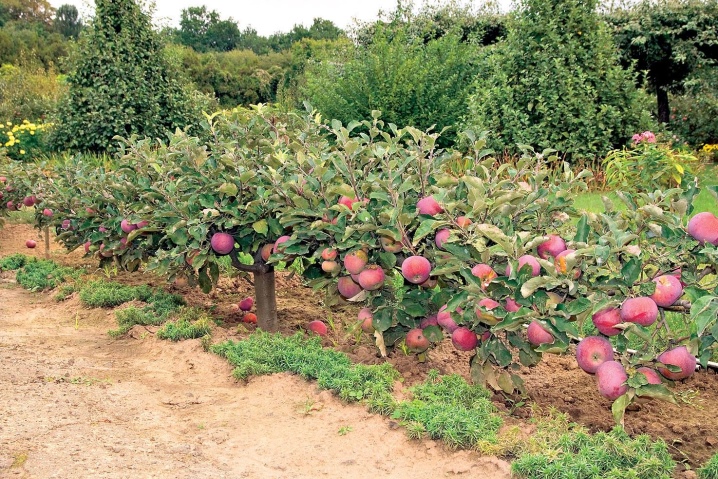
Step-by-step instruction
Before planting, the seedlings are placed in a container with warm water for 12-15 hours, and a growth stimulator is often added. In addition, an aqueous solution is prepared with the addition of clay, the roots are dipped in it before placing the plant in the pit.
One columnar apple tree for normal growth and development requires an area equal to ¼ m2. On 2.5 m2, 10 trees of this species can be planted and harvested regularly. Saplings grafted onto tall rootstocks will require more space than dwarf varieties.
Planting material is best purchased in specialized nurseries that have proven themselves well.
Typically, plants are sold in closed-root containers and are labeled with the variety name, description, and general care guidelines.
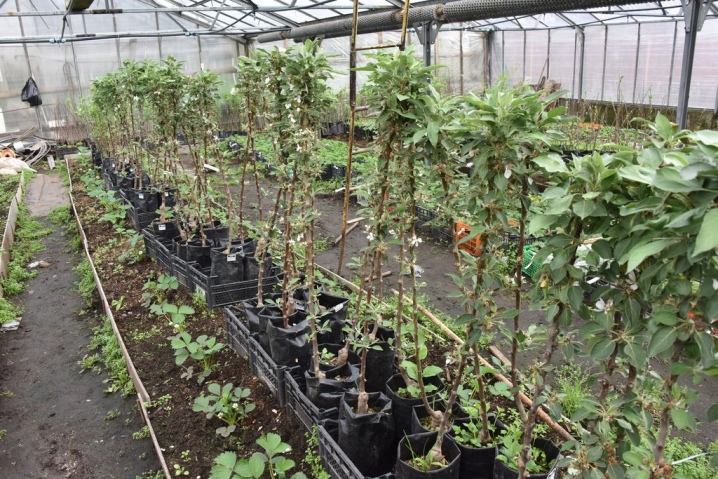
If the plant is purchased from a market where the conditions for keeping young trees do not always meet the standard, attention should be paid to the condition of the roots, trunk and wood. Are there any damages, breaks, signs of decay.
During transportation, the roots are wrapped in a damp cloth, they should not dry out. It is best to make the purchase just before the disembarkation procedure.
It is necessary to plant young trees when the air temperature warms up to +15 degrees, and return frosts stop. One-year-old seedlings take root better than two-year old ones. Plants purchased in a container can also be planted in summer.
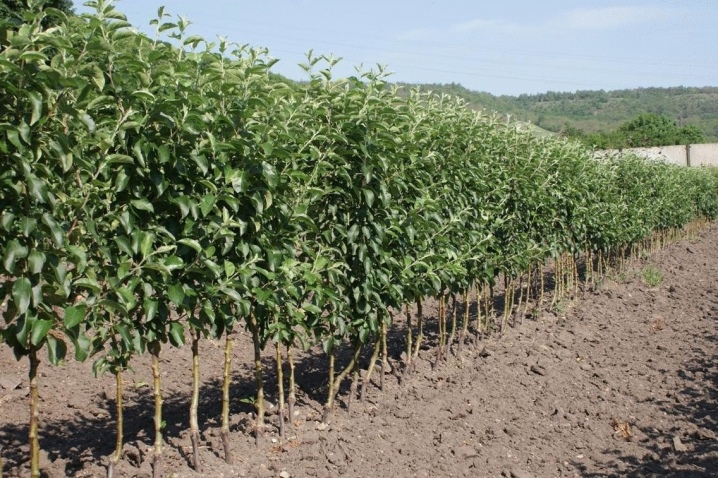
How to plant correctly
- A planting pit is prepared, which is filled with a fertile mixture, making an embankment in the form of a hill.
- The root system of the plant is placed in a root stimulant solution for 8 hours.
- Then the roots are slightly pruned to stimulate their growth, the place of the cut is sprinkled with ash.
- The tree is placed in the finished hole, the root system is straightened along the edges of the embankment. The upper part of the root growth line (root collar) should be 4-6 cm above the soil surface. The grafting site should be turned to the south.
- A support is installed next to it - a peg made of linden or hazel.
- Fall asleep only with fertile soil, which remained when digging a hole, up to half and watered 0.5 buckets of water. Then the remaining soil is poured out and a hole with sides 2-3 cm high is formed.
- The earth is compacted and moistened with 2 buckets of water at room temperature.
- The water is allowed to soak, after which the trunk circle is mulched with peat or shavings, grass.
- Tie the seedling to the support with twine, securing it with a figure eight. If the root collar begins to deepen into the soil, the tree is tightened with a strapping.
These simple rules will help even a novice gardener to plant a columnar apple tree on the site accurately and in a short time.
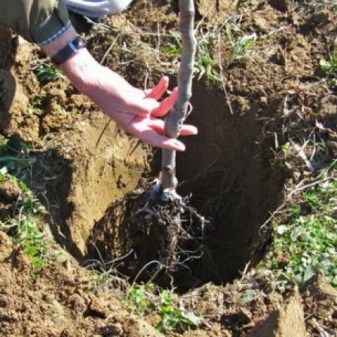
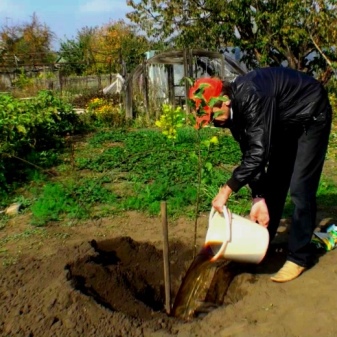
Follow-up care
After planting, a young tree must be looked after so that it takes root, overwinters safely, and two years later pleases with the first harvest.
If the seedlings were planted in the spring, then the recommendations will be as follows.
- 2 weeks after planting, pour the root-stimulating composition ("Kornevin", "Epin").
- Water regularly (you can equip a drip irrigation system), in the absence of rain, irrigate once every 3-5 days, and after 2 weeks - abundant watering. In August, watering is reduced by 2 times, in September it is stopped.
- Remove weeds and loosen (they do this very carefully, since the root system of the tree is fibrous in structure and located on the surface).
- Mulch after watering (sawdust, hay) or plant green manures (cereals, mint, coriander, dill).
- Feed 3 times per season after watering. From the first year, foliar spraying with a urea solution is done: 2-3 tbsp. spoons for 10 liters of water.
- Root feeding begin to be applied only after 2 years or if planted in the fall. They introduce organic fertilizers and ammonium nitrate in the spring, in June - complex mixtures, for example, nitroammofoska, in August - potash and phosphorus fertilizers, for example, wood ash.
- In the first two years remove all ovaries so that the plants grow stronger.
- In the second year, young shoots are cut in spring, leaving 2 buds on the branches, the extra side shoots are removed while they are still green. According to the recommendations, the apical buds are not touched in order to ensure the growth of the tree. (In practice, there are several ways to prune a columnar apple tree. Some gardeners do not grow a straight stem in the form of a column, but form 2-3 branch ones on one trunk. It is believed that this will increase the efficiency of fruiting.)
- The apical kidney is cut only after the culture has reached the size of an adult tree.
- Conduct preventive spraying from pests with insecticides (Fitoverm), but only before flowering. After leaf fall, they are treated with Bordeaux liquid, and for the winter they sprinkle Zashchita soil around the trunk.
- For the prevention of fungal diseases are used Fitosporin, Trichodermin, Pharmayod.
- If there are wounds, they are covered up "Pharmayodom"The trunks are whitewashed with lime or garden paint.
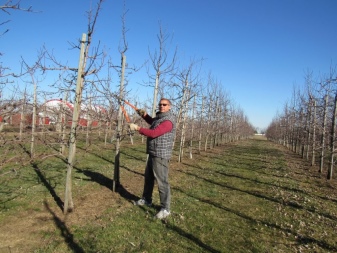
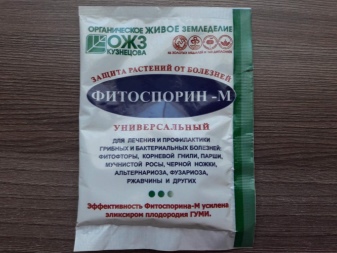
When planting in autumn, first of all, you should take care of the shelter of the plant for the winter.
- Spread an additional layer of soil or peat around the roots.
- Mulch the soil with sawdust and a layer of spruce branches to keep the roots from freezing.
- The trunk and branches in the northern regions are wrapped in geotextiles.
- To protect against hares, an iron mesh or an old metal bucket without a bottom is installed around the seedlings, wrapped with roofing material.
- For small rodents, nylon materials are used (for example, tights), they are covered with kerosene or diesel fuel.
The bark can be sprayed with copper sulphate or the "Summer resident" product.
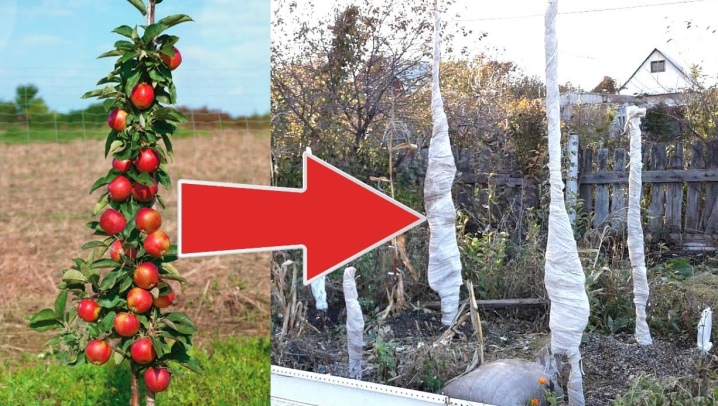













The comment was sent successfully.